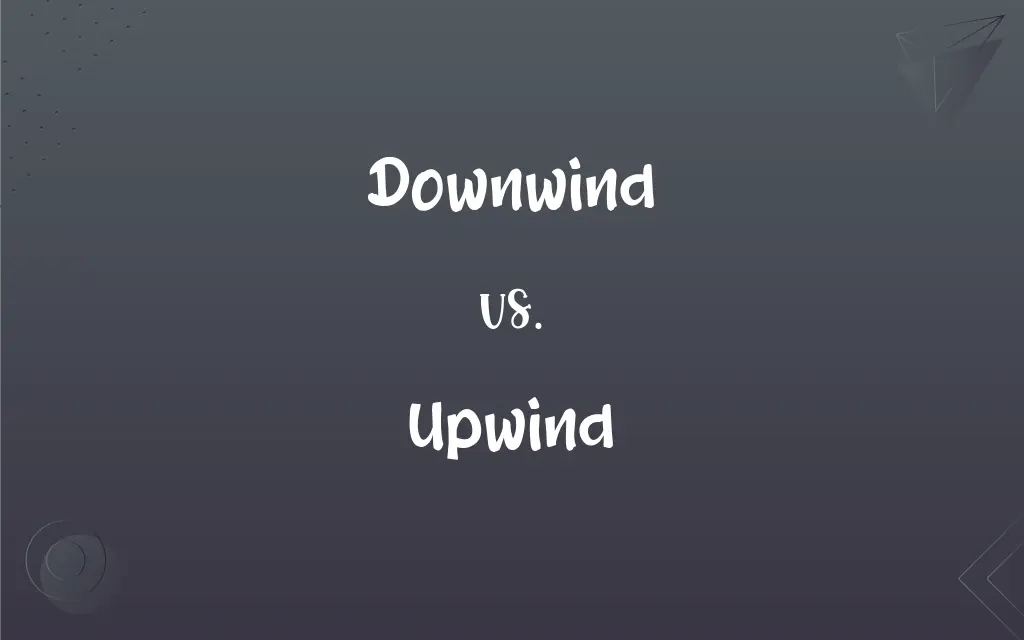Downwind vs. Upwind: What's the Difference?
Edited by Aimie Carlson || By Janet White || Updated on November 11, 2023
"Downwind" refers to the direction the wind is blowing towards, while "upwind" is the direction from which the wind is coming.

Key Differences
"Downwind" indicates the direction towards which the wind is blowing, often carrying scents or sounds with it. While, "upwind" points to the source of the wind, often a cleaner or fresher direction since it's where the wind originates.
In navigation or aviation, traveling downwind means moving with the wind at one's back, which can aid in speed and efficiency. Traveling upwind, however, means moving against the wind, which can be more challenging and require more energy.
When considering pollution or odor control, being downwind of a source means you're more likely to detect or be affected by it. Being upwind means being in a position less affected by such emissions.
In sailing, downwind courses are often faster and require different sail settings than upwind courses, which need more tacking and strategic maneuvering.
Downwind areas can be more susceptible to receiving fallout or debris from activities like construction, whereas upwind areas are typically clearer of such influence.
ADVERTISEMENT
Comparison Chart
Direction
Towards which the wind blows
From which the wind originates
Navigation/Airflow
Moving with the wind; easier
Moving against the wind; requires more effort
Pollution/Odor
More likely to detect emissions
Less affected by emissions
Sailing
Faster courses, different sail settings
Requires tacking, more strategy
Environmental Impact
More susceptible to fallout or debris
Typically clearer of such influence
ADVERTISEMENT
Downwind and Upwind Definitions
Downwind
In the direction that the wind is blowing towards.
The farm is located downwind of the factory, often receiving its smoke.
Upwind
The windward direction in nautical terms.
Sailing upwind required careful tacking and navigation.
Downwind
Being in a position where the wind blows something towards you.
Downwind of the bakery, the smell of fresh bread was overwhelming.
Upwind
Towards the source or origin of the wind.
Birds often migrate upwind to utilize the air currents effectively.
Downwind
On the side away from the wind.
They set up camp downwind to avoid smoke from the campfire.
Upwind
On the side facing the wind.
The wind turbines were positioned upwind to capture the strongest winds.
Downwind
The leeward direction in nautical terms.
The boat sailed downwind, making the journey smoother.
Upwind
In the direction from which the wind is coming.
The hikers walked upwind to avoid the smoke from the forest fire.
Downwind
The direction in which a scent or pollution is carried by the wind.
They noticed the odor from the landfill while standing downwind.
Upwind
Being in a position where the wind is blowing away from you.
Upwind of the chemical plant, they didn't notice any unpleasant smells.
Downwind
In the direction in which the wind blows.
Upwind
In or toward the direction from which the wind blows.
Downwind
In the same direction as the wind is blowing
Upwind
Exposed to the wind
Downwind
Positioned relative to something in such a way that it can be smelled in the wind
I don't want to live downwind from a pig farm.
Upwind
In the direction from which the wind is blowing
Downwind
(aviation) in the direction opposite that of landing in a traffic pattern
Upwind
To wind upwards.
Downwind
On the side or in the direction away from the direction from which the wind is blowing; in the direction toward which the wind is blowing; as, good hunters stay downwind of their prey. Opposite of upwind, and windward.
Upwind
To wind up (a mechanism).
Downwind
Towards the side away from the wind
Upwind
To wind up.
Downwind
In the direction the wind is blowing;
They flew downwind
Upwind
Being or moving in the direction from which the wind is blowing.
Downwind
Away from the wind;
They were sailing windward
Upwind
Towards the side exposed to wind
Upwind
Toward the wind;
They were sailing leeward
Upwind
In the direction opposite to the direction the wind is blowing;
They flew upwind
FAQs
What is the meaning of downwind?
Downwind means in the direction towards which the wind is blowing.
Why is being downwind important in sailing?
Being downwind in sailing helps with faster movement as the wind aids in propulsion.
Is it easier to smell things downwind?
Yes, scents are often more detectable downwind as the wind carries odors in that direction.
How is upwind defined?
Upwind is the direction from which the wind originates.
How does upwind benefit wind turbines?
Positioning wind turbines upwind ensures they capture the strongest and most consistent winds.
Can weather patterns be predicted by downwind conditions?
Downwind conditions can give clues about weather patterns, especially in terms of where weather systems are moving.
What challenges does upwind present in aviation?
Flying upwind in aviation can be challenging due to increased air resistance.
Can downwind affect the spread of fire?
Yes, fires can spread rapidly downwind due to the wind carrying the flames and heat.
What is the strategic advantage of being upwind in battle?
Being upwind in battle can provide a strategic advantage by keeping smoke and gasses away.
How does being upwind affect scent tracking in animals?
Animals often position themselves upwind to prevent their scent from reaching prey.
Is upwind sailing more difficult than downwind?
Yes, upwind sailing can be more difficult due to the need for strategic tacking against the wind.
How does smoke disperse in a downwind direction?
Smoke disperses downwind as it is carried along by the wind's flow.
Why is it important to consider downwind conditions in agriculture?
Considering downwind conditions in agriculture is important to avoid pesticide drift to neighboring areas.
How does pollution travel downwind?
Pollution travels downwind as the wind carries contaminants in that direction.
Why do pilots prefer landing downwind?
Pilots usually prefer not to land downwind; landing upwind is often safer due to better control against the wind.
How do plants adapt to upwind and downwind conditions?
Plants adapt to these conditions by altering growth patterns and seed dispersal strategies.
What impact does downwind have on air quality?
Air quality can be poorer downwind of pollution sources due to the accumulation of pollutants.
What is the significance of downwind in environmental studies?
In environmental studies, downwind analysis is crucial for assessing the impact of pollutants and emissions.
Can downhill and downwind mean the same thing?
No, downhill refers to terrain slope, while downwind refers to wind direction.
How do birds use upwind conditions during migration?
Birds use upwind conditions to gain lift and conserve energy during migration.
About Author
Written by
Janet WhiteJanet White has been an esteemed writer and blogger for Difference Wiki. Holding a Master's degree in Science and Medical Journalism from the prestigious Boston University, she has consistently demonstrated her expertise and passion for her field. When she's not immersed in her work, Janet relishes her time exercising, delving into a good book, and cherishing moments with friends and family.
Edited by
Aimie CarlsonAimie Carlson, holding a master's degree in English literature, is a fervent English language enthusiast. She lends her writing talents to Difference Wiki, a prominent website that specializes in comparisons, offering readers insightful analyses that both captivate and inform.
































































